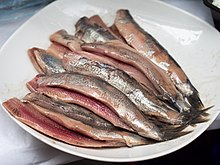Soused herring

Brined herring, Netherlands
|
|
| Place of origin | Netherlands |
|---|---|
| Main ingredients | Herring, vinegar; any of cider, wine, tea, sugar, herbs (usually bay leaf), spices (usually mace), chopped onion |
| |
|
Soused herring is herring soaked in a mild preserving liquid. It can be raw herring in a mild vinegar pickle or Dutch brined herring. As well as vinegar, the marinade might contain cider, wine or tea, sugar, herbs (usually bay leaf), spices (usually mace), chopped onion.
The word 'soused' can also describe a marinated herring that has been cooked. The herring can be baked in the marinade or fried and then soaked in it. It is served cold.
The soused herring (maatjesharing or just maatjes in Dutch, or matjes in German and Swedish) is an especially mild salt herring, which is made from young immature herrings. The herrings are ripened for a couple of days in oak barrels in a salty solution, or brine. The pancreatic enzymes which support the ripening make this version of salt herring especially mild and soft. Raw herring pickled in vinegar are called rollmops.
As of 2015, within the EU, Dutch made Hollandse Nieuwe, Holländischer Matjes and Hollandse maatjesharing has TSG Certification and German produced Glückstädter Matjes, produced in Schleswig-Holstein have PGI certification.
This process of preparing herring (known as "gibbing") was developed in the Middle Ages by the Dutch. Herrings are caught between the end of May and the beginning of July in the North Sea near Denmark or Norway, before the breeding season starts. This is because herrings at this time are unusually rich in oils (over 15%) and their roe and milt have not started to develop.
...
Wikipedia
